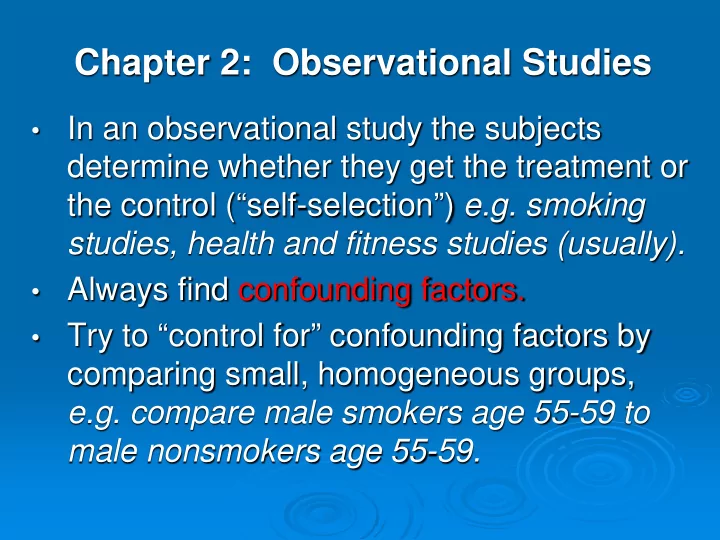

Chapter 2: Observational Studies In an observational study the subjects • determine whether they get the treatment or the control (“self-selection”) e.g. smoking studies, health and fitness studies (usually). Always find confounding factors. • Try to “control for” confounding factors by • comparing small, homogeneous groups, e.g. compare male smokers age 55-59 to male nonsmokers age 55-59.
Crosstabs help, BUT we don’t know all the possible confounding • factors we can’t split over very many things • because the comparison groups become too small
Association is not Causation Just because two things are associated, it does not necessarily imply that one of them causes the other one. Confounding factors might be driving the association. “Pellagra” • Cervical cancer and circumcision • Ultrasound and low birthweight • Chocolate and car accidents •
Example 1. Children of women who smoked during pregnancy scored 9 points less, on average, in IQ tests at ages 3 and 4 than children of nonsmokers. Does this imply that smoking during pregnancy causes the baby to have a lower IQ? Suggest a possible confounding factor.
Example 2. People who exercise tend to live longer than those who don’t exercise. Does this imply that exercising causes people to live longer? Suggest a possible confounding factor.
Simpson’s Paradox 8442 men applied, 44% of them were admitted • • 4321 women applied, 35% of them were admitted Did UC Berkeley discriminate against women?
Simpson’s Paradox Example (hypothetical): Job A: 19 men, 1 woman, all earn $70,000 Job B: 19 women, 1 man, all earn $50,000 Overall: Average for men = $69,000 Average for women = $51,000 Why? Women tend to have the lower-paying job.
Simpson’s Paradox, Summary Overall averages or percentages can be • misleading. If we want to understand what’s going • on, we need to look at the averages or percentages at the decision-making level, i.e. break up the data into homogeneous groups.
Recommend
More recommend